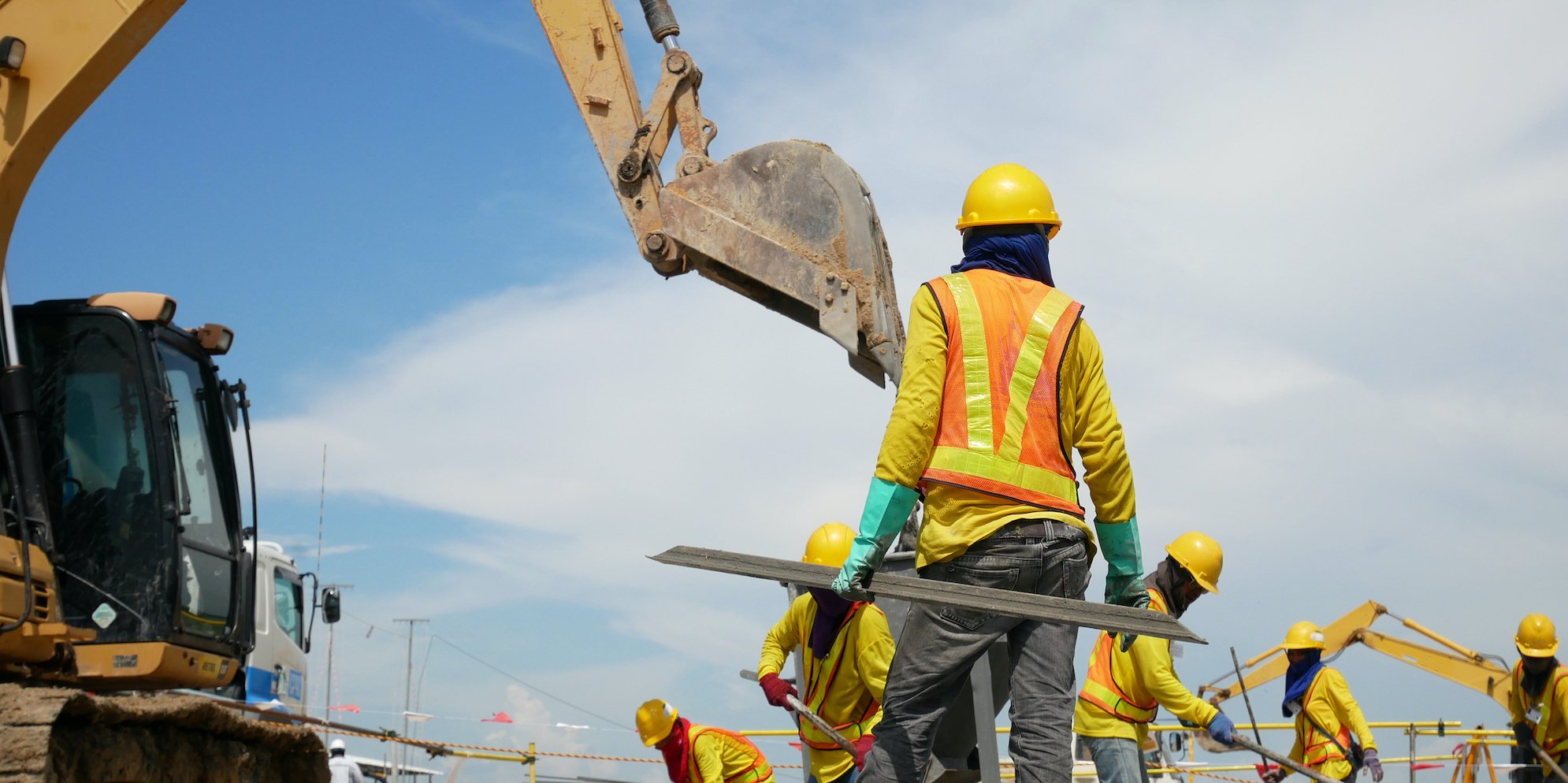Highway and road construction projects are essential to ensure our infrastructure is fit to support us well into the future. However, highway work zones have extensive safety hazards. Passenger vehicles, construction vehicles, and construction equipment all pose a threat to workers. Unfortunately, an average of 124 workers—a total of 2,103 between 2003 and 2019—are killed at highway and road construction sites each year, according to the Bureau of Labor Statistics.
Here, we discuss five highway work zone safety best practices front-line supervisors can implement to mitigate safety hazards and protect workers from serious and fatal injuries.
Best practices for worker safety in highway work zones
1. Ensure proper work zone layout
Whether due to inclement weather, high traffic volume or speeds, or poor lighting and visibility, highway work zones are incredibly dangerous. Workers on foot, in particular, are at risk of being struck by passenger vehicles or construction equipment. Ensuring proper work zone layout—from the length of advance warning, transition, activity, and termination areas to the location and spacing of temporary traffic control devices—reduces the chances of safety incidents.
Every highway work zone should be set up in accordance with the current edition of the Manual on Uniform Traffic Control Devices (MUTCD), the national standard for design and set up for work zones. For specific information regarding temporary traffic control (TTC) projects, such as road construction and utility work, refer to part 6 of the document (beginning on page 547).
Importantly, supervisors should document the work zone layout at the beginning of every project. Each day, they should evaluate the effectiveness of the temporary traffic controls they have set up by walking or riding the job site to look for skid marks, damaged barricades, or other signs of near misses and make necessary changes. Supervisors should document and make workers aware of changes as they occur.
Check out: 7 Ways to be More Proactive About Worker Safety
2. Prioritize work zone safety training
The importance of ensuring workers are knowledgeable about safety hazards related to highway work zones and are properly trained to mitigate those hazards cannot be understated. Too often, fatal injuries in highway work zones occur because workers make mistakes. Simply standing in the wrong place, for example, can result in a safety incident.
By continuously focusing on safety training, supervisors can reduce the risk of serious injuries. All workers should be trained to recognize symbols, markers, and colors used to separate workers on foot from equipment within the work space. Additionally, everyone should understand hand signals used when workers on foot are required to be in the same area as equipment. Equipment operators should also be trained to never move equipment without first making positive visual contact with any workers on foot near the equipment. Importantly, all workers should know they have the authority to stop work if they identify a safety hazard.
Each day, hold a toolbox talk to discuss and report safety hazards and close calls and to talk about safety considerations related to that day’s work. Also consider including workers in walk-throughs or drive-throughs to highlight any changes to the work zone layout and emphasize that safety is an unceasing concern and priority.
Related: 7 Steps for Successful Safety Stand Downs
3. Scrutinize clothing and equipment
Highway work zones will always have safety risks, but ensuring the proper use of protective clothing and equipment mitigates those risks.
It’s advisable for all workers, including those operating vehicles, to wear high visibility safety apparel, but it’s essential for workers on foot who must be easy to spot at all times. Supervisors should inspect workers’ apparel each day to ensure it has not lost retroreflective properties and that the color has not faded. Pay special attention to flaggers, who are most at risk of injury from passenger vehicles. In addition to high visibility clothing, flaggers should also use devices such as flashing slow/stop paddles, which further increase their visibility.
When it comes to equipment, supervisors should ensure temporary traffic control devices such as signage, warning devices, paddles, and concrete barriers are in place at all times, are used in a consistent manner, and are working properly. Missing traffic or inconsistent control devices could create a situation where passenger vehicles inadvertently enter or exit the work zone in the wrong place.
It’s also vital to perform daily inspections of construction equipment. Maintenance and repairs should be done in a timely fashion, and supervisors should maintain records of all repair work. Importantly, a construction vehicle’s controls should be made inoperable during all maintenance or repairs so it is not moved by another worker while repairs are being done.
Read: What is Lockout/Tagout? An Intro to Hazardous Energy Control
4. Create an internal traffic control plan
Passenger vehicles pose an undeniable threat to workers in highway work zones, but workers can also be struck by construction equipment and other vehicles within the work zone. According to the National Institute for Occupational Safety and Health (NIOSH) report “Building Safer Highway Work Zones: Measures to Prevent Worker Injuries From Vehicles and Equipment,” workers on foot are as likely to be struck by a construction vehicle as by a passing traffic vehicle. Backing vehicles are a particular safety hazard, accounting for half of fatalities of workers on foot within the confines of the work zone.
Creating an internal traffic control plan that coordinates the flow of construction equipment and vehicles is one way to improve safety within the work zone. In general, a traffic control plan should separate workers on foot from construction vehicles as much as possible. The entire work zone should also be marked using temporary pavement markers that indicate pedestrian-free areas and flow-of-traffic lines. These markers should be installed so workers will recognize them as guides but the public will not notice or respond to them.
5. Control for aggressive driving
According to the aforementioned NIOSH report, the majority of fatal injuries involving workers on foot and pedestrian vehicles involved motorists leaving the traffic space and intruding into the work zone. Unfortunately, worker safety experts say this type of aggressive driving is on the rise.
"Work zone intrusions are what keeps me up at night,” said Bryan Adams, Director of Safety Services/Occupational Safety at NiSource at the Urbint Anticipate 2021 conference. “We have prepared, over the years, for distracted drivers and intoxicated drivers. But, last year, 38 percent of 47 [intrusions] were due to aggressive drivers with intentional actions. This year, 67 percent are aggressive drivers with intentional actions.”
It’s difficult to control for aggressive driving and work zone intrusions, but it’s not impossible. A few best practices include:
- Giving motorists plenty of advanced warning of upcoming work zones and, when possible, sharing estimated time of delay so they have sufficient time to alter their route if desired.
- Setting up temporary traffic control equipment within a reasonable time prior to the start of construction, so motorists are not complacent when work begins.
- Keeping the length of the work zone appropriate to the work in progress, so motorists do not speed after passing through a long stretch with no sign of work activity.
- Covering or taking down warning signs when workers are not present in the work zone.
With the passing of the Infrastructure Investment and Jobs Act in late 2021, highway and road construction is guaranteed to increase in the coming years. Start implementing these best practices now to ensure workers are better protected from safety hazards now and in the future.
For more worker safety information, check out “10 Keystones of a Successful Worker Safety Program.”

